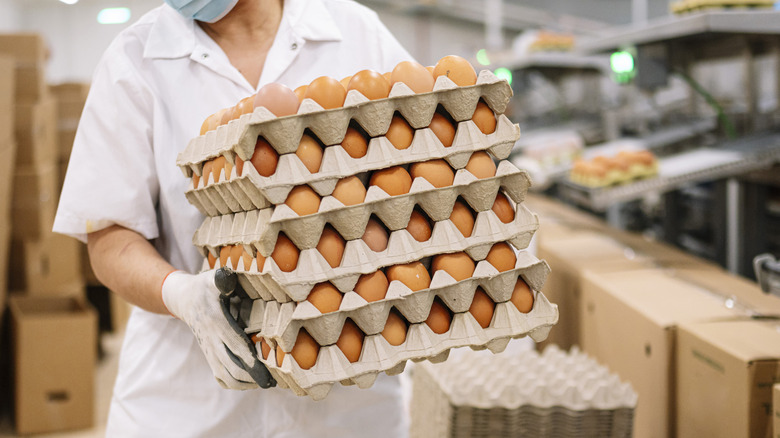The US State That Produces More Eggs Than The Rest Of The Country
Iowa has been leading the nation's egg production for years. Other states like Ohio and Indiana come close, each producing over 10 billion eggs each since 2020, but Iowa tops the charts with around 16.4 billion eggs annually. In general, the Midwest is largely responsible for the majority of the eggs produced in the United States — in 2020 alone, that meant 96.9 billion eggs. In 2024, the USDA National Agricultural Statistics Service recorded 13.4 billion eggs laid in Iowa. While these numbers are slightly lower than what the state itself records, both estimates far outpace the rest of the country. The Iowa egg industry provides over 7,000 jobs to locals — and generated over $2.62 billion in 2018 alone.
Perhaps unsurprisingly, Iowa is the top producer of a number of resources in the United States. Chickens, pigs, ethanol, and biodiesel are all primarily sourced in the Heartland state. Not to mention, Iowa notably produces the most corn in the country, which is a large factor in its egg success. The abundance of corn and soybeans provides ample feed for their chickens, ensuring they are well taken care of and in a good position to lay eggs. Iowa produced around 44 million laying hens in 2018, and its self-sufficiency in feeding them helps to keep costs down compared to competing states. As far as business acumen goes, Iowan egg farmers have been able to keep up with market changes and increasing transportation costs. What's more, the chicken manure acts as an excellent fertilizer for the state's large grain industry, thus limiting waste and maximizing output from their birds.
Challenges to Iowa's egg industry
While Iowa's leadership in eggs is well-cemented, there are general threats to the egg industry that affect all states. In 2024, the United States saw a one percent decline in production. This was largely due to ongoing Avian flu outbreaks that started in 2022, leading to various recalls. A shortage of laying hens and an increased cost of chicken feed led to inflated egg costs. Luckily for Iowa, it was able to mitigate some of these losses due to growing much of its own corn.
Another challenge is increasing transportation costs. Truck transportation prices fluctuate more than rail costs, putting Iowa at a disadvantage. Still, the state has been able to offset a lot of these costs by keeping its feeding costs low and improving its existing transportation system. The U.S. has shifted over the last few years to cage-free chicken farming systems. As such, Iowa farmers note that fewer hens can share the same buildings, which leads to fewer eggs overall, just from a shortage of supply. In January 2025, egg prices reached a record high, and there was a distinct lack of supply in supermarkets. While egg costs are expected to stay high, Iowa farmers are largely seeing a recovery of lost hens, so you may be seeing more farm-fresh eggs near you soon enough.


